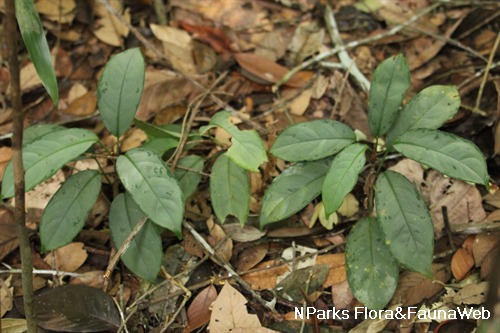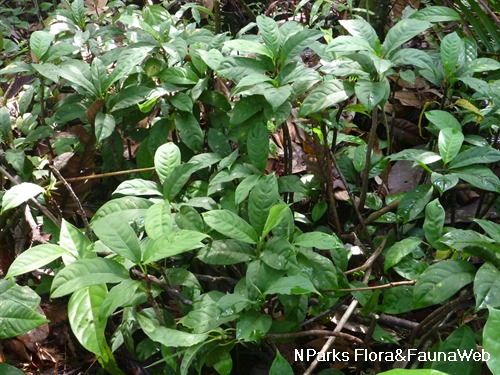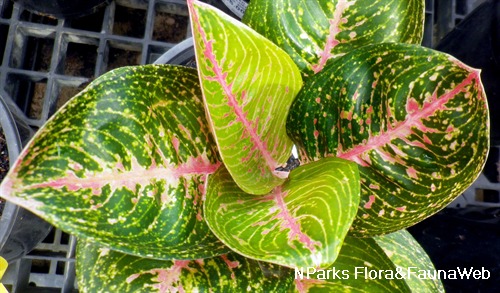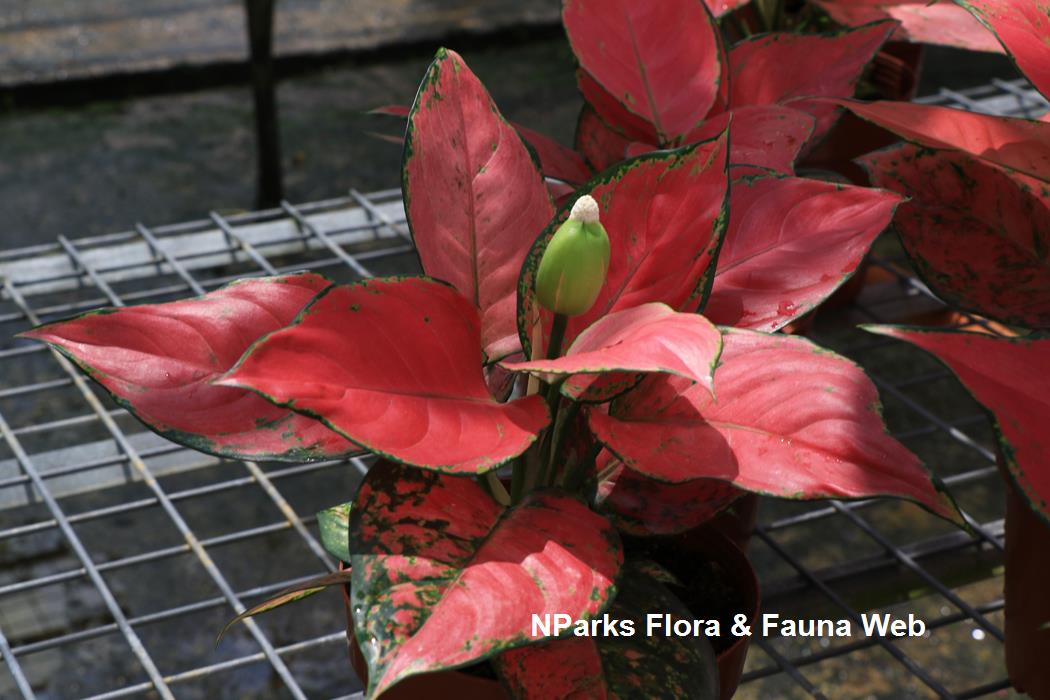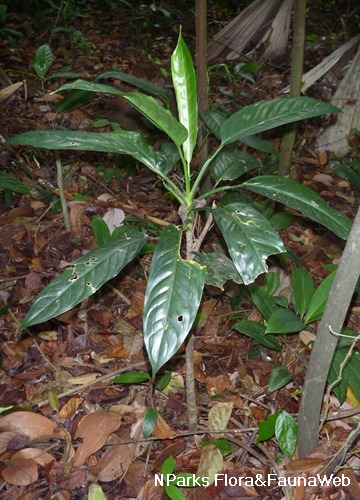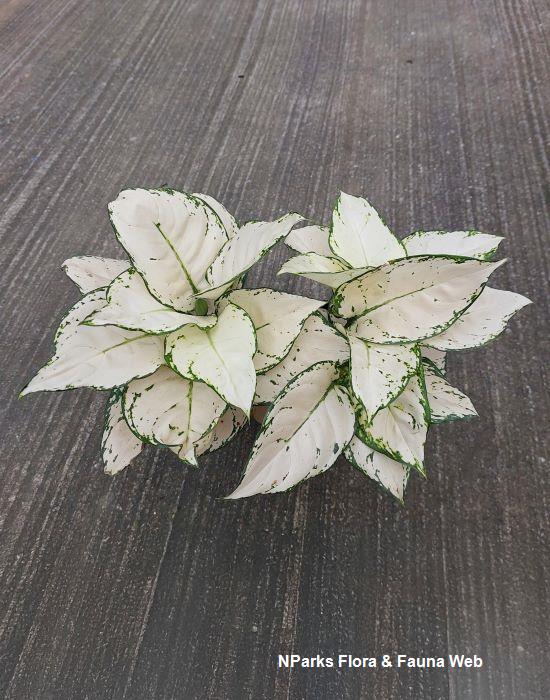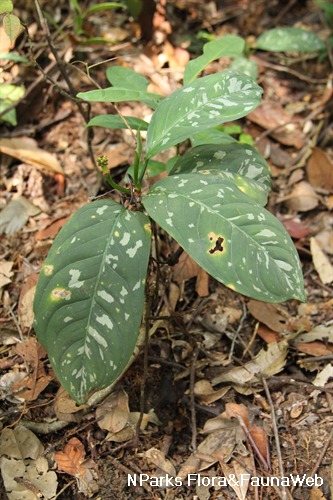
Back
Aglaonema nebulosum N.E.Br.
| Family Name: | Araceae |
| Synonyms: | Aglaonema minus Hook.f., Aglaonema pictum var. nanum (Hook.f.) Ridl., Aglaonema pictum var. scortechinii (Hook.f.) Ridl., Aglaonema scortechinii Hook.f. |
| Common Name: | Mata Bisul |
Name
Classifications and Characteristics
| Plant Division | Angiosperms (Flowering Seed Plants) (Monocotyledon) |
|---|---|
| Plant Growth Form | Herbaceous Plant |
| Lifespan (in Singapore) | Perennial |
| Mode of Nutrition | Autotrophic |
| Maximum Height | 10 cm to 60 cm |
Biogeography
| Native Distribution | Sumatra, Peninsular Malaysia, Singapore, and Borneo. |
|---|---|
| Native Habitat | Terrestrial |
| Preferred Climate Zone | Tropical |
| Local Conservation Status | Native to Singapore (Endangered (EN)) |
Description and Ethnobotany
| Growth Form | It is a herb up to 10–60 cm tall, with thick and straight stems. It can be identified by its green leaves with irregular ashy or silvery patches on the upper surface. |
|---|---|
| Foliage | Its spirally arranged, stalked, leaves have leathery leaf blades that are usually narrowly drop-shaped to narrowly oval-oblong, green with occasional irregular ashy or silvery patches above, lighter green below, ending abruptly with sharp tip, and 6.5–20 by 2.5–7 cm. |
| Flowers | Its erect inflorescence is enclosed within a light green to whitish, 1-2 cm-long spathe (petal-like, modified leaf) that ends abruptly with a sharp tip. The whitish female flowers emerge above the spathe in a round, swollen, white mass, while the male flowers remain within the spathe. |
| Fruit | Its fruits are oval, dark red, and 0.7–2 by 0.4–0.9 cm. |
| Habitat | It grows in peat and freshwater swamp forests. It occurs locally in Nee Soon swamp forest. |
| Associated Fauna | Its flowers are insect-pollinated, and its fruits are probably dispersed by birds or mammals. |
| Cultivation | It can be propagated by seed and stem cuttings. |
| Etymology | Greek aglos, clear, gleaming; Greek nema, thread, stamen, possibly referring to the bright appearance of the stamens; Latin nebula, cloud, referring to the irregular ashy or silvery patches on the upper surface of the leaves. |
Landscaping Features
| Landscaping | This herb is suitable for planting in shaded and wet areas of parks and large gardens. Its attractive green leaves with irregular silvery patches on the upper surface add colour and diversity to the landscape. |
|---|---|
| Desirable Plant Features | Ornamental Foliage |
| Landscape Uses | General, Parks & Gardens, Small Gardens, Interiorscape/ Indoor Plant |
| Thematic Landscaping | Silver Garden |
Fauna, Pollination and Dispersal
| Fauna Pollination Dispersal Associated Fauna | Bird-Attracting |
|---|---|
| Pollination Method(s) | Biotic (Fauna) |
| Seed or Spore Dispersal | Biotic (Fauna) |
Plant Care and Propagation
| Light Preference | Semi-Shade, Full Shade |
|---|---|
| Water Preference | Lots of Water, Moderate Water |
| Plant Growth Rate | Moderate |
| Rootzone Tolerance | Moist Soils, Waterlogged Soils (Drains Site, Does not Drain Site) |
| Transplanting Tolerance | Good |
| Propagation Method | Seed, Stem Cutting (Herbaceous) |
Foliar
| Foliage Retention | Evergreen |
|---|---|
| Mature Foliage Colour(s) | Green |
| Mature Foliage Texture(s) | Leathery |
| Foliar Type | Simple / Unifoliate |
| Foliar Arrangement Along Stem | Alternate |
| Foliar Attachment to Stem | Petiolate |
| Foliar Shape(s) | Non-Palm Foliage (Ovate, Oval, Elliptical, Oblong) |
| Foliar Venation | Pinnate / Net |
| Foliar Margin | Entire |
| Foliar Apex - Tip | Acuminate |
Non - Foliar and Storage
| Stem Type & Modification | Herbaceous |
|---|---|
| Root Type | Underground |
Floral (Angiosperm)
| Flower & Plant Sexuality | Unisexual Flowers |
| Flower Colour(s) | White |
|---|---|
| Flower Grouping | Cluster / Inflorescence |
| Flower Location | Terminal |
| Inflorescence Type | Spathe & Spadix |
| Inflorescence Size | 2 m |
Fruit, Seed and Spore
| Mature Fruit Colour(s) | Red |
|---|---|
| Mature Fruit Texture(s) | Smooth |
| Fruit Classification | Simple Fruit |
| Fruit Type | |
| Seed Quantity Per Fruit | Few (1-5) |
Image Repository
Others
| Master ID | 31172 |
|---|---|
| Species ID | 5566 |
| Flora Disclaimer | The information in this website has been compiled from reliable sources, such as reference works on medicinal plants. It is not a substitute for medical advice or treatment and NParks does not purport to provide any medical advice. Readers should always consult his/her physician before using or consuming a plant for medicinal purposes. |


